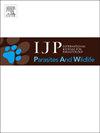Cestodes in Eurasian wolves (Canis lupus lupus) and domestic dogs (Canis lupus familiaris) in Switzerland
IF 2
3区 医学
Q3 ECOLOGY
International Journal for Parasitology-Parasites and Wildlife
Pub Date : 2024-11-30
DOI:10.1016/j.ijppaw.2024.101027
引用次数: 0
Abstract
Eurasian wolves (Canis lupus lupus) and domestic dogs (Canis lupus familiaris) are definitive hosts of numerous cestode species. While infections with adult stages in canids are usually subclinical, some species pose a zoonotic risk or cause infections in wildlife and livestock, resulting in disease and/or economic losses. This study aimed to determine the prevalence, species composition, and geographical distribution of cestode infections in dogs and free-ranging wolves in Switzerland. Faecal samples from 2065 dogs and intestinal content from 121 necropsied wolves were macroscopically examined and tested using zinc chloride flotation method. When cestode eggs or adult cestodes were detected, a molecular identification based on multiplex-PCR and sequencing was performed. In the sampled wolves, the prevalence by flotation (42/121; 34.7%) was lower than the overall prevalence including macroscopic examination (76/121; 62.8%). The flotation method thus failed to detect cestode infections in 44.7% (34/76) of infected wolves. The most frequently detected species was Taenia hydatigena (46/121; 38.0%), followed by Taenia serialis (23/121; 19.0%), Mesocestoides spp. (3/121; 2.5%), Taenia ovis (1/121; 0.8%), and Echinococcus multilocularis (1/121; 0.8%). In the analysed dogs, the prevalence was 0.9% (19/2065), but the real prevalence is very likely to be higher, as no necropsy data were available. Identified cestode species included Taenia crassiceps (6/2065; 0.3%), E. multilocularis (3/2065; 0.1%), Mesocestoides sp. (2/2065; 0.1%), Taenia polyacantha (1/2065; 0.05%), and Dibothriocephalus latus (1/2065; 0.05%). By identifying the cestode species infecting two closely related host species with markedly different lifestyles, this study sheds light on the local distribution of these parasites and their potential impacts on wildlife, livestock, and human health. Due to their close contact with humans, infected dogs represent an important source of infection with zoonotic cestodes such as Echinococcus spp. and certain Taenia species, responsible for serious human diseases.

瑞士欧亚狼(Canis lupus lupus)和家犬(Canis lupus familiaris)的绦虫。
欧亚狼(Canis lupus lupus)和家犬(Canis lupus familiaris)是许多动物物种的最终宿主。虽然犬科动物的成年期感染通常是亚临床的,但有些物种具有人畜共患风险或在野生动物和牲畜中引起感染,造成疾病和/或经济损失。本研究旨在确定瑞士的狗和自由放养的狼中寄生虫感染的流行程度、种类组成和地理分布。采用氯化锌浮选法对2065只狗的粪便和121只死狼的肠道内容物进行了宏观检查和检测。当检测到卵或成虫时,进行基于多重pcr和测序的分子鉴定。在取样的狼中,漂浮的患病率(42/121);34.7%)低于包括宏观检查在内的总体患病率(76/121;62.8%)。因此,浮选法在感染的狼中检测不出寄生虫感染的比例为44.7%(34/76)。检出率最高的是带绦虫(46/121;38.0%),其次是带绦虫(23/121;19.0%), Mesocestoides spp (3/121;2.5%),鹅带绦虫(1/121;0.8%),多房棘球蚴(1/121;0.8%)。在分析的狗中,患病率为0.9%(19/2065),但由于没有尸检数据,实际患病率很可能更高。鉴定的绦虫种包括带绦虫(6/2065;0.3%),多房棘(3/2065;0.1%), Mesocestoides sp. (2/2065;0.1%),多棘带绦虫(1/2065;0.05%),以及二bothricephalus latus (1/2065;0.05%)。通过鉴定两种生活方式明显不同、关系密切的寄主感染的寄生虫种类,本研究揭示了这些寄生虫在当地的分布及其对野生动物、牲畜和人类健康的潜在影响。由于与人类密切接触,受感染的狗是人畜共患绦虫(如棘球绦虫和某些带绦虫)感染的重要来源,可导致严重的人类疾病。
本文章由计算机程序翻译,如有差异,请以英文原文为准。
求助全文
约1分钟内获得全文
求助全文
来源期刊

International Journal for Parasitology-Parasites and Wildlife
Medicine-Infectious Diseases
CiteScore
3.80
自引率
5.60%
发文量
113
审稿时长
45 days
期刊介绍:
The International Journal for Parasitology: Parasites and Wildlife (IJP-PAW) publishes the results of original research on parasites of all wildlife, invertebrate and vertebrate. This includes free-ranging, wild populations, as well as captive wildlife, semi-domesticated species (e.g. reindeer) and farmed populations of recently domesticated or wild-captured species (e.g. cultured fishes). Articles on all aspects of wildlife parasitology are welcomed including taxonomy, biodiversity and distribution, ecology and epidemiology, population biology and host-parasite relationships. The impact of parasites on the health and conservation of wildlife is seen as an important area covered by the journal especially the potential role of environmental factors, for example climate. Also important to the journal is ''one health'' and the nature of interactions between wildlife, people and domestic animals, including disease emergence and zoonoses.
 求助内容:
求助内容: 应助结果提醒方式:
应助结果提醒方式:


